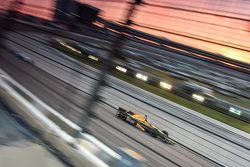IndyCar: “Teams have to adapt” to domed skids
IndyCar’s VP of competition and engineering Bill Pappas has said teams need to find setups that work with new superspeedway skids – but also hinted there may be scope for changing the rules following tests.

Photo by: Michael C. Johnson











Although today (Tuesday) is a Chevrolet ‘manufacturer test day’ at Indianapolis Motor Speedway, Marco Andretti’s Honda-powered Andretti Autosport car will also be running in order to give the IndyCar competition department a chance to make comparisons with as few variables as possible, with both types of car running domed skids.
Pappas told Motorsport.com: “It’s a Chevrolet manufacturers’ test day, but they have allowed us to run a Honda to do some back to back testing at the same race track on the same day to get some sense of the behavior of both cars with domed skids.
“Then Wednesday is a test for all cars, where we say, ‘Imagine what you could be running in the week up to qualifications for the Indy 500.’ We’d like to see test lists from each manufacturer and try and get through all those combinations to be sure that when we get there for the Month of May, we won’t have any surprises.”
Pappas said the controversial domed skids, which James Hinchcliffe has slammed as “asinine” and harmful to the quality of racing on the superspeedways, are likely to stay, but he will be listening to all views.
“It’s in the rulebook that this is going to be part of the kit for Indianapolis, Texas and Pocono, and both manufacturers knew that.
“But we are trying to create the best chance to have a great 100th Indy 500, and so we thought it was in everyone’s interests to do a back to back test at IMS, and then take the input and data and make a decision one way or the other.
“They [Schmidt Peterson Motorsports and Hinchcliffe] tested at Fontana and that is nothing like Indianapolis Motor Speedway. So let’s get everyone together and do a good analytical study and listen to the drivers.”
Safety for all is a priority
Pappas emphasized that the employment of the domes was primarily for the safety of competitors and fans in the grandstands, following last year’s practice sessions which saw three cars spin and flip upside down once they were traveling backward at high speed.
While the new flaps on the beam wing are meant to prevent any recurrence of this issue, IndyCar has decided that slowing the cars during rotation – which is the theory behind the domed skids – long before they reach that 180-degree point is a worthy safety measure.
Pappas insisted: “After the safety issues we had last year, both manufacturers were heavily involved in how to move forward, this was the solution and this is now in the rules. Nobody can afford to have situations like occurred last May.
“Thank God nothing got through the fences, but we’ve got to constantly look at the value of safety. The series is most concerned about safety for all – competitors and spectators.
“That is the foremost criteria for us doing anything. And it was established by our participants and partners that domed skids would be part of that progress in safety.”
Teams and drivers can adapt
Pappas admitted he was bemused by the strident reaction against the use of the domed skids, and suggested that teams needed to get used to altering the car to fit the rules, rather than expecting it to be the other way around.
“As a former race engineer, I can say that you adapt around what you’re given,” he said, “and if your setup doesn’t work, well, then you carry on adapting your setups until they do work.
“Race teams adapt. When I was a race engineer, long before the current IndyCar Series or even IRL, we adapted. We’d be given a set of rules and then it was up to us to do the best we could with what we had been given.
“I can’t reiterate enough that both manufacturers knew these were the rules for Indianapolis. They were very concerned about the problems through the Month of May, we all continued to work on it right through the summer, had several meetings, and all decided ‘Let’s go forward with this.’”
Be part of Motorsport community
Join the conversationShare Or Save This Story
Subscribe and access Motorsport.com with your ad-blocker.
From Formula 1 to MotoGP we report straight from the paddock because we love our sport, just like you. In order to keep delivering our expert journalism, our website uses advertising. Still, we want to give you the opportunity to enjoy an ad-free and tracker-free website and to continue using your adblocker.















Top Comments